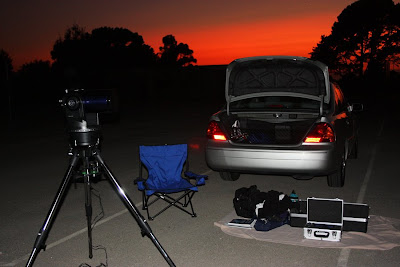
All-in-all, it was a good night of viewing. I spent most of it searching for new objects, globular clusters this time, which my scope really isn't good for. In my small scope, they mostly look like fuzz-balls. It is hard to see any individual stars. But some of the fuzz-balls were large, some small, some bright, some dim. Some had such a bright center that you would think they were a single star instead of tens of thousands to millions of stars gravitationally bound together. Clusters inhabit the galactic halo which surrounds our Milky Way and other spiral galaxies. The stars in such clusters are thought to be among the oldest stars in the galaxy. The clusters I viewed that night were M3, M4, M9, M54, M69, M70 and NGC 6544. Most were in the constellation Sagittarius or nearby Scorpius and Ophiuchus which are in the southern sky right now and away from the city lights here in Los Angeles.
For the first time, I was able to view the Ring Nebula, M57, with my own scope! I was very excited about that. There was no color, just a gray haze, and no "diamond" in the ring (a faint star that can be seen along one edge), but I was happy.
We also spent a fair amount of time looking at Jupiter. It was stunning that evening. I saw the red spot for the first time with my own scope and at 8:16 p.m. or so, Io popped out of eclipse. Here is a movie that one of the guys put together of a similar event that took place just the other night on September 6. Look to the left of the planet and you will see Io suddenly appear. The movie was made from photos taken over the course of a three-hour time span which shows you how fast Jupiter revolves on its axis. On the night we were observing, the red spot moved completely across the face of the planet.
This club member has taken some fantastic and inspiring photos of the stars. Astrophotography is an area that I would love to get into myself. I have the equipment, I just need to learn how to use it.

No comments:
Post a Comment